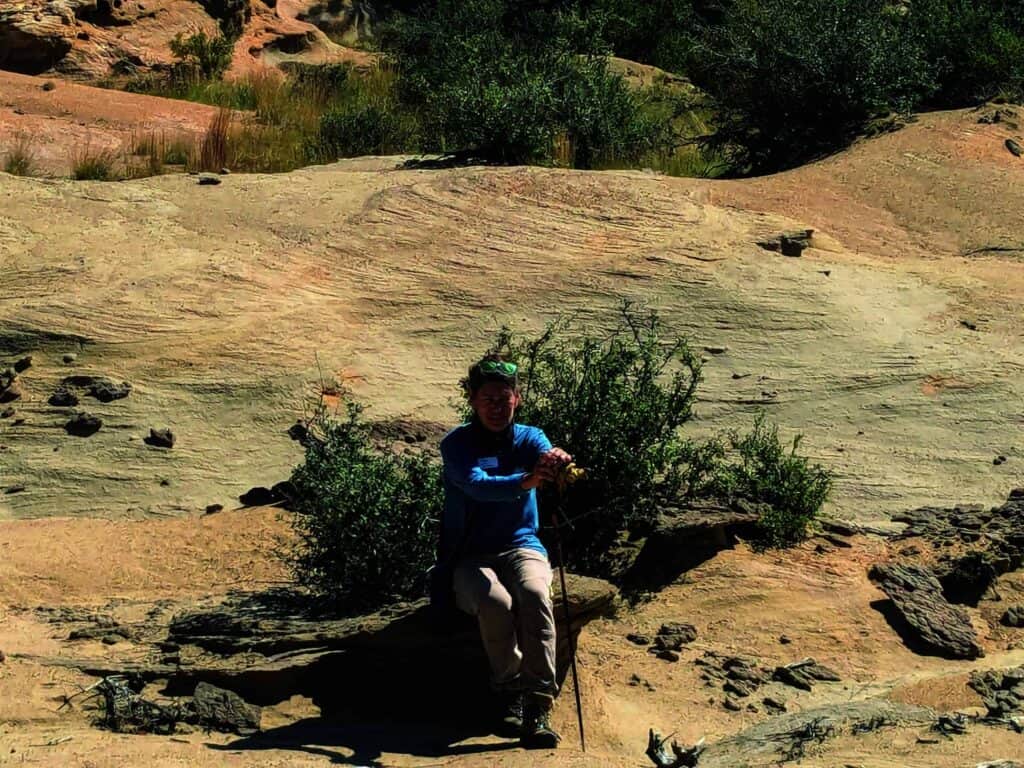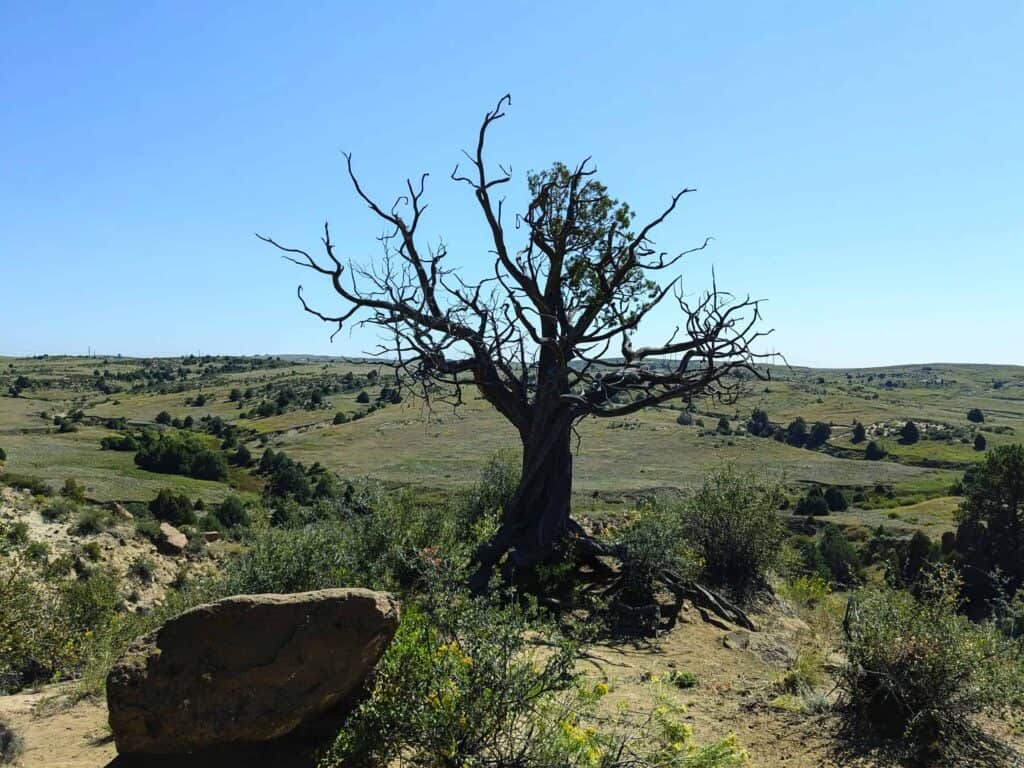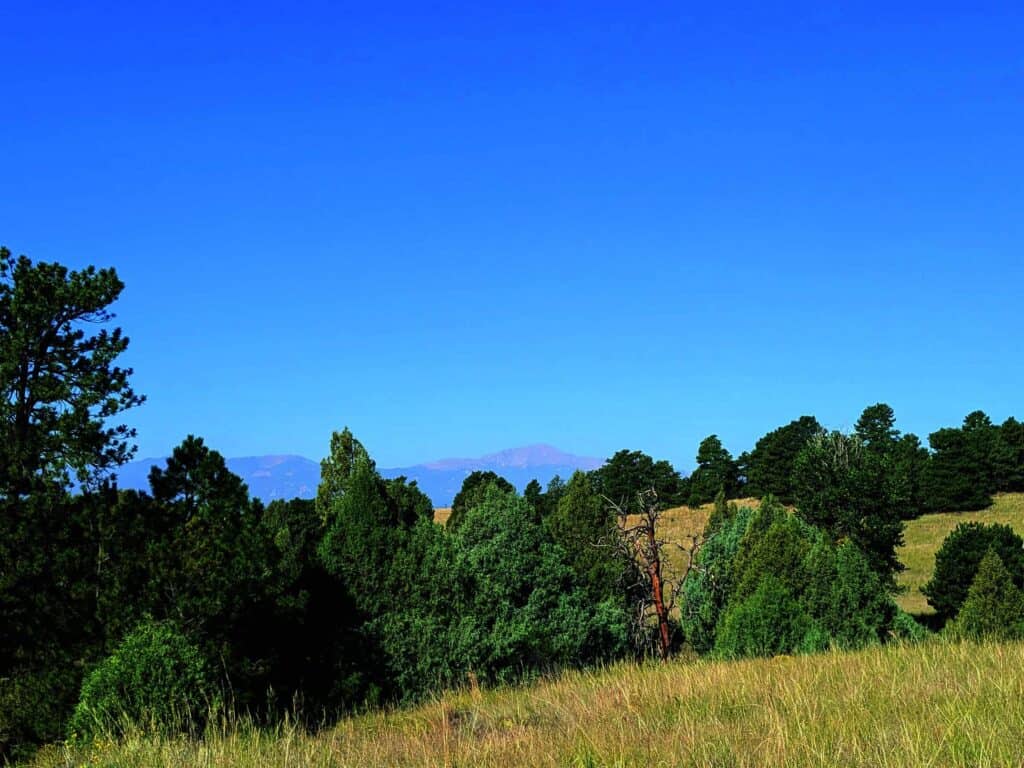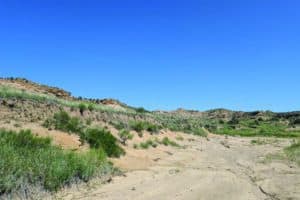Coben Scott is a history graduate, a history buff, and he has explored and researched much of Falcon and the area’s past. Coben’s column, Yesteryear, features stories about the history of the plains.
Touring Jimmy Camp
By Coben Scott
Heath Gay, publisher of “Colorado Springs: The Most Significant Sites In The City,” organized a tour through the historic grounds of Jimmy Camp on Sept. 13. Jax Hilaine, a resident of Falcon since 2002 and a volunteer from the Corral Bluffs Association, guided the tour.

Corral Bluffs and Jimmy Camp are located on the eastern edge of Colorado Springs, in between Highway 24 and Highway 94.
Starting the tour, Hilaine said that archeologists believe Jimmy Camp is more culturally important than the Four Corners area. Along with anthropologists, they have agreed that about 48 different tribes lived on and utilized the land throughout the centuries.
Paleo-Indian artifacts dating back thousands of years are scattered across the land and creek bed of Jimmy Camp. In a recent tour, an attendee accidentally stumbled across a 2,000-plus-year-old piece of pottery that is one of the largest collected from the area.
Paleontologists also hold high regard for this land as petrified tree stumps dating back 65 million years have been uncovered and are currently being researched. Around the same period and later, dinosaur and prehistoric mammal fossils are being uncovered, some of which are featured in the Denver Museum of Nature and Science. Biologists, botanists and ornithologists alike all study on the site as well. It’s noted that so many crucial species of flora and fauna thrive on the acreage. Some of the more important examples are the nesting grounds of red tail hawks, grazing and breeding for pronghorn and elk, the growth of Colorado’s only native poppy and the unexplainable presence of two cholla cacti, along with an abundance of ponderosa pines wooding the plains. The area’s recent history also proves to be something of interest.

Before there was Jimmy Camp, there was Jimmy. The identity of Jimmy is unknown and debated. Some sources claim he was an explorer who settled, others say he was a trapper, but what is known is sometime during the late 1820s to early 1830s, a man who went by Jimmy established a trading post with the local native population. This would make Jimmy the first documented American to live in Colorado.
Jimmy’s death was documented by a famous westerner, James Beckwourth, when he supposedly stopped by Jimmy’s cabin only to find him robbed and dead. Beckwourth rallied together a crew of natives to successfully track down the murderers and hang them by their toes. Afterward, the group buried Jimmy and marked his grave with a large stone. According to one primary source, many decades later a family who lived in Jimmy’s cabin dug up his bones and displayed them in their home.
Regardless of rumors and legends surrounding Jimmy himself, his trading post/camp proved to be an important place for a long time. Kit Carson and John Fremont camped and stocked up on supplies there after getting lost through Bijou Basin, being run up a hill by natives and having to kill and eat a sickly grizzly. The likes of mountain men such as “Honest” Jim Baker and William Sublette, writers like Rufage Sage and Francis Parkman, and herders Charles Goodnight and Oliver Loving all utilized Jimmy Camp as a crucial resting spot on their adventures.
For fur trappers and mountain men, the Trapper’s Trail was established, stretching from Bent’s Fort to Fort Laramie — Jimmy Camp was greatly utilized. The Cherokee Trail that would lead to the Colorado Gold Rush treated Jimmy Camp the same. Charles Goodnight used not only Jimmy Camp, but also Corral Bluffs next to it as a key spot on his journeys. Goodnight used the naturally forming corrals at the bottom of the bluffs (hence the name) to hold his cattle before resting up at Jimmy Camp. Roughly 10 million longhorns came through the area because of Goodnight.

As it became privatized, Matt France was an early owner of Jimmy Camp Ranch. France was one of the first mayors of Colorado Springs, as well as the founder of Franceville, an abandoned coal mine town just south of Corral Bluffs. When Falcon was being established, most of the wells for homes tapped into the aquifer used by the north spring for Jimmy Camp Creek. Ruth Banning and Raymond Lewis eventually purchased the land, Lewis transported a train car to the old camp to have an unofficial city hall. At the “city hall,” many of Jimmy’s high class friends discussed business ventures and also partied. At that point, Jimmy Camp’s history was coming to an end.
In the late 2000s, the relevance of Jimmy Camp heightened once again as talks of creating a reservoir, similar to Pueblo Reservoir State Park, were on the table. They would flood much of the valley, and it would serve as a recreational site for the area. However, when native tribes relevant to the area’s past were asked if the land held any significant spots, the chiefs pointed to the entire stretch of the creek along with other locations in the area that would have featured the proposed lake.
With those plans defunct, the city of Colorado Springs eventually annexed the area and purchased more land surrounding it for future plans to create a public historic park in Jimmy Camp. A potential park would probably include off-limit sections for continued studies and excavating. Many locals would like to see bison reintroduced to the future park, similar to the Rocky Mountain Arsenal in Denver.
Jimmy Camp represents 200 years of history, right in Falcon’s backyard. It seems that interest in the area has piqued again.
The Corral Bluffs Alliance (https:/corralbluffs.org), offers free guided tours of Jimmy Camp and Corral Bluffs. Hilaine said this about the tours, “You can come here multiple times and never get the same thing twice.”




